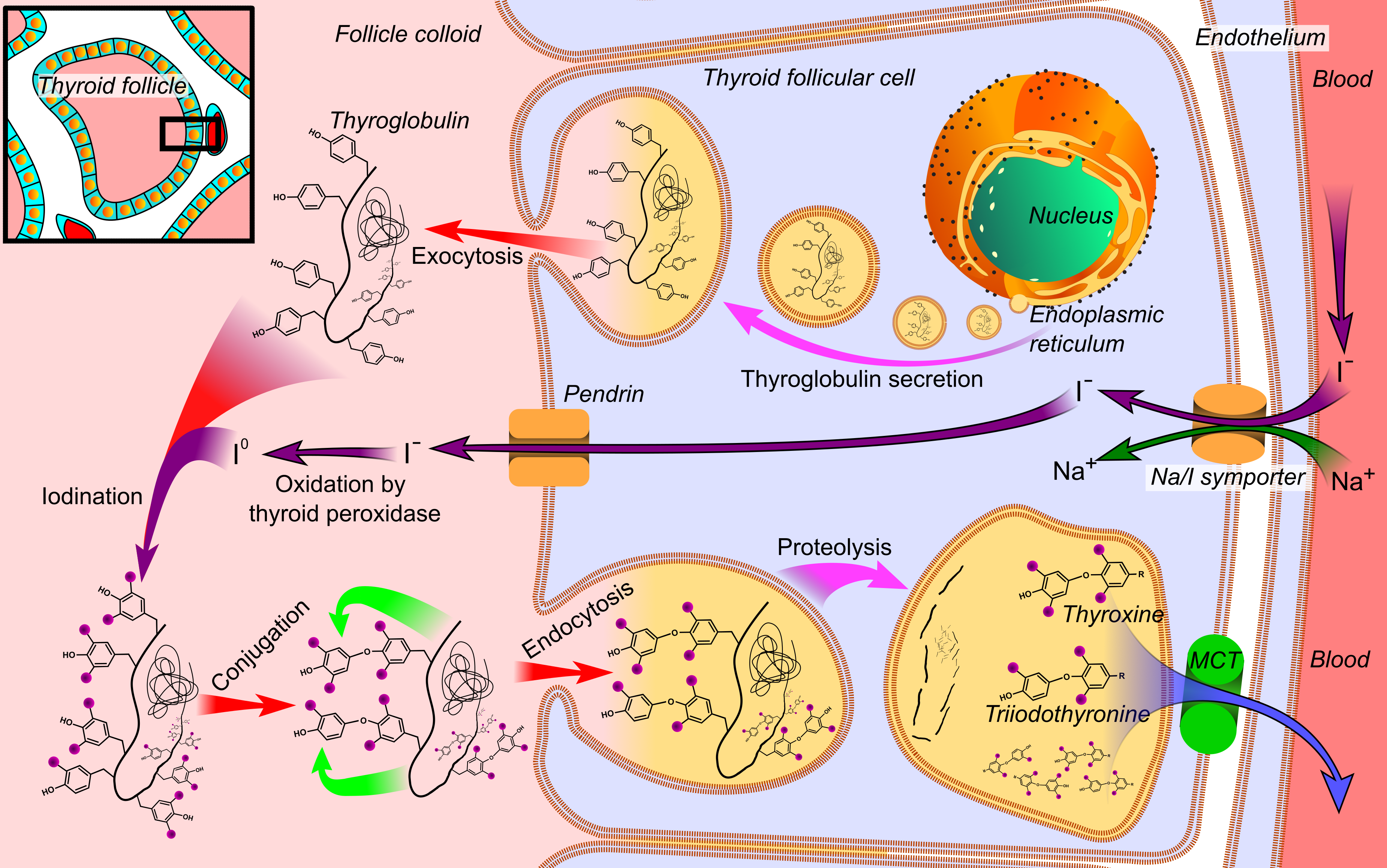|
Goiter
A goitre (British English), or goiter (American English), is a swelling in the neck resulting from an enlarged thyroid gland. A goitre can be associated with a thyroid that is not functioning properly. Worldwide, over 90% of goitre cases are caused by iodine deficiency. The term is from the Latin ''gutturia'', meaning throat. Most goitres are not cancerous (benign), though they may be potentially harmful. Signs and symptoms A goitre can present as a palpable or visible enlargement of the thyroid gland at the base of the neck. A goitre, if associated with hypothyroidism or hyperthyroidism, may be present with symptoms of the underlying disorder. For hyperthyroidism, the most common symptoms are associated with adrenergic stimulation: tachycardia (increased heart rate), palpitations, nervousness, tremor, increased blood pressure and heat intolerance. Clinical manifestations are often related to hypermetabolism (increased metabolism), excessive thyroid hormone, an increase in oxy ... [...More Info...] [...Related Items...] OR: [Wikipedia] [Google] [Baidu] |
Iodine Deficiency
Iodine deficiency is a lack of the trace element iodine, an essential nutrient in the diet. It may result in metabolic problems such as goiter, sometimes as an endemic goiter as well as congenital iodine deficiency syndrome due to untreated congenital hypothyroidism, which results in developmental delays and other health problems. Iodine deficiency is an important global health issue, especially for fertile and pregnant women. It is also a preventable cause of intellectual disability. Iodine is an essential dietary mineral for neurodevelopment among children. The thyroid hormones thyroxine and triiodothyronine contain iodine. In areas with little iodine in the diet, typically remote inland areas where no marine foods are eaten, deficiency is common. It is common in mountainous regions where food is grown in iodine-poor soil. Prevention includes adding small amounts of iodine to table salt, a product known as ''iodized salt''. In areas of deficiency, iodine compounds have ... [...More Info...] [...Related Items...] OR: [Wikipedia] [Google] [Baidu] |
Hyperthyroidism
Hyperthyroidism is a endocrine disease in which the thyroid gland produces excessive amounts of thyroid hormones. Thyrotoxicosis is a condition that occurs due to elevated levels of thyroid hormones of any cause and therefore includes hyperthyroidism. Some, however, use the terms interchangeably. Signs and symptoms vary between people and may include irritability, muscle weakness, sleeping problems, a tachycardia, fast heartbeat, heat intolerance, diarrhea, goitre, enlargement of the thyroid, hand tremor, and weight loss. Symptoms are typically less severe in the elderly and during pregnancy. An uncommon but life-threatening complication is thyroid storm in which an event such as an infection results in worsening symptoms such as confusion and a hyperthermia, high temperature; this often results in death. The opposite is hypothyroidism, when the thyroid gland does not make enough thyroid hormone. Graves' disease is the cause of about 50% to 80% of the cases of hyperthyroidism ... [...More Info...] [...Related Items...] OR: [Wikipedia] [Google] [Baidu] |
Hyperplasia
Hyperplasia (from ancient Greek ὑπέρ ''huper'' 'over' + πλάσις ''plasis'' 'formation'), or hypergenesis, is an enlargement of an organ or tissue caused by an increase in the amount of Tissue (biology), organic tissue that results from cell proliferation. It may lead to the Gross anatomy, gross enlargement of an organ, and the term is sometimes confused with benign neoplasia or benign tumor. Hyperplasia is a common preneoplastic response to stimulus. Microscopically, cells resemble normal cells but are increased in numbers. Sometimes cells may also be increased in size (hypertrophy). Hyperplasia is different from hypertrophy in that the Cellular adaptation, adaptive cell change in hypertrophy is an increase in the cell size, ''size'' of cells, whereas hyperplasia involves an increase in the ''number'' of cells. Causes Hyperplasia may be due to any number of causes, including proliferation of basal layer of epidermis to compensate skin loss, Chronic inflammation, chr ... [...More Info...] [...Related Items...] OR: [Wikipedia] [Google] [Baidu] |
Tachycardia
Tachycardia, also called tachyarrhythmia, is a heart rate that exceeds the normal resting rate. In general, a resting heart rate over 100 beats per minute is accepted as tachycardia in adults. Heart rates above the resting rate may be normal (such as with exercise) or abnormal (such as with electrical problems within the heart). Complications Tachycardia can lead to fainting. When the rate of blood flow becomes too rapid, or fast blood flow passes on damaged endothelium, it increases the friction within vessels resulting in turbulence and other disturbances. According to the Virchow's triad, this is one of the three conditions (along with hypercoagulability and endothelial injury/dysfunction) that can lead to thrombosis (i.e., blood clots within vessels). Causes Some causes of tachycardia include: * Adrenergic storm * Anaemia * Anxiety * Atrial fibrillation * Atrial flutter * Atrial tachycardia * Atrioventricular reentrant tachycardia * AV nodal reentrant tachy ... [...More Info...] [...Related Items...] OR: [Wikipedia] [Google] [Baidu] |
Palpitations
Palpitations occur when a person becomes aware of their heartbeat. The heartbeat may feel hard, fast, or uneven in their chest. Symptoms include a very fast or irregular heartbeat. Palpitations are a sensory symptom. They are often described as a skipped beat, a rapid flutter, or a pounding in the chest or neck. Palpitations are not always the result of a physical problem with the heart and can be linked to anxiety. However, they may signal a arrhythmia, fast or irregular heartbeat. Palpitations can be brief or long-lasting. They can be intermittent or continuous. Other symptoms can include dizziness, shortness of breath, sweating, headaches, and chest pain. There are a variety of causes of palpitations not limited to the following: Palpitation may be associated with coronary artery disease, coronary heart disease, perimenopause, hyperthyroidism, adult heart muscle diseases like hypertrophic cardiomyopathy, congenital heart diseases like atrial septal defects, diseases causing ... [...More Info...] [...Related Items...] OR: [Wikipedia] [Google] [Baidu] |
Nervousness
Anxiety is an emotion characterised by an unpleasant state of inner turmoil and includes feelings of dread over anticipated events. Anxiety is different from fear in that fear is defined as the emotional response to a present threat, whereas anxiety is the anticipation of a future one. It is often accompanied by nervous behavior such as pacing back and forth, somatic complaints, and rumination. Anxiety is a feeling of uneasiness and worry, usually generalized and unfocused as an overreaction to a situation that is only subjectively seen as menacing. It is often accompanied by muscular tension, restlessness, fatigue, inability to catch one's breath, tightness in the abdominal region, nausea, and problems in concentration. Anxiety is closely related to fear, which is a response to a real or perceived immediate threat (fight-or-flight response); anxiety involves the expectation of a future threat including dread. People facing anxiety may withdraw from situations which have ... [...More Info...] [...Related Items...] OR: [Wikipedia] [Google] [Baidu] |
Tremor
A tremor is an involuntary, somewhat rhythmic muscle contraction and relaxation involving neural oscillations, oscillations or twitching movements of one or more body parts. It is the most common of all involuntary movements and can affect the hands, arms, eyes, face, head, vocal folds, trunk, and legs. Most tremors occur in the hands. In some people, a tremor is a symptom of another neurological disorder. Types Tremor is most commonly classified by clinical features and cause or origin. Some of the better-known forms of tremor, with their symptoms, include the following: * Cerebellar tremor (also known as intention tremor) is a slow, broad tremor of the extremities that occurs at the end of a purposeful movement, such as trying to press a button or touching a finger to the tip of one's nose. In classic cerebellar tremor, a lesion on one side of the brain produces a tremor in that same side of the body that worsens with directed movement. Cerebellar damage can also produce a "win ... [...More Info...] [...Related Items...] OR: [Wikipedia] [Google] [Baidu] |
Hypertension
Hypertension, also known as high blood pressure, is a Chronic condition, long-term Disease, medical condition in which the blood pressure in the artery, arteries is persistently elevated. High blood pressure usually does not cause symptoms itself. It is, however, a major risk factor for stroke, coronary artery disease, heart failure, atrial fibrillation, peripheral arterial disease, vision loss, chronic kidney disease, and dementia. Hypertension is a major cause of premature death worldwide. High blood pressure is classified as essential hypertension, primary (essential) hypertension or secondary hypertension. About 90–95% of cases are primary, defined as high blood pressure due to non-specific lifestyle and Genetics, genetic factors. Lifestyle factors that increase the risk include excess salt in the diet, overweight, excess body weight, smoking, physical inactivity and Alcohol (drug), alcohol use. The remaining 5–10% of cases are categorized as secondary hypertension, d ... [...More Info...] [...Related Items...] OR: [Wikipedia] [Google] [Baidu] |
Hypermetabolism
Hypermetabolism is defined as an elevated resting energy expenditure (REE) > 110% of predicted REE. Hypermetabolism is accompanied by a variety of internal and external symptoms, most notably extreme weight loss, and can also be a symptom in itself. This state of increased metabolic activity can signal underlying issues, especially hyperthyroidism. Patients with Fatal familial insomnia can also present with hypermetabolism; however, this universally fatal disorder is exceedingly rare, with only a few known cases worldwide. The drastic impact of the hypermetabolic state on patient nutritional requirements is often understated or overlooked as well. Signs and symptoms Symptoms may last for days, weeks, or months until the disorder is healed. The most apparent sign of hypermetabolism is an abnormally high intake of calories followed by continuous weight loss. Internal symptoms of hypermetabolism include: peripheral insulin resistance, elevated catabolism of protein, carbohydrates an ... [...More Info...] [...Related Items...] OR: [Wikipedia] [Google] [Baidu] |
Heat Intolerance
Heat intolerance is a symptom characterized by feeling overheated in warm environments or when the surrounding environment's temperature rises. Typically, the person feels uncomfortably hot and sweats excessively. Compared to heat illnesses like heatstroke, heat intolerance is usually a symptom of endocrine disorders, drugs, or other medical conditions, rather than the result of too much exercise or hot, humid weather. Symptoms * Feeling subjectively hot * Sweating, which may be excessive In patients with multiple sclerosis (MS), heat intolerance may cause a pseudoexacerbation, which is a temporary worsening of MS-related symptoms. A temporary worsening of symptoms can also happen in patients with postural orthostatic tachycardia syndrome (POTS) and dysautonomia. Diagnosis Diagnosis is largely made from the patient history, followed by blood tests and other medical tests to determine the underlying cause. In women, hot flashes must be excluded. Causes Excess thyroid hormone ... [...More Info...] [...Related Items...] OR: [Wikipedia] [Google] [Baidu] |
Thyroid Hormones
File:Thyroid_system.svg, upright=1.5, The thyroid system of the thyroid hormones T3 and T4 rect 376 268 820 433 Thyroid-stimulating hormone rect 411 200 849 266 Thyrotropin-releasing hormone rect 297 168 502 200 Hypothalamus rect 66 216 386 256 Anterior pituitary gland rect 66 332 342 374 Negative feedback rect 308 436 510 475 Thyroid gland rect 256 539 563 635 Thyroid hormones rect 357 827 569 856 Catecholamine rect 399 716 591 750 Metabolism desc bottom-left Thyroid hormones are two hormones produced and released by the thyroid gland, triiodothyronine (T3) and thyroxine (T4). They are tyrosine-based hormones that are primarily responsible for regulation of metabolism. T3 and T4 are partially composed of iodine, derived from food. A deficiency of iodine leads to decreased production of T3 and T4, enlarges the thyroid tissue and will cause the disease known as simple goitre. The major form of thyroid hormone in the blood is thyroxine (T4), whose half-life of arou ... [...More Info...] [...Related Items...] OR: [Wikipedia] [Google] [Baidu] |








